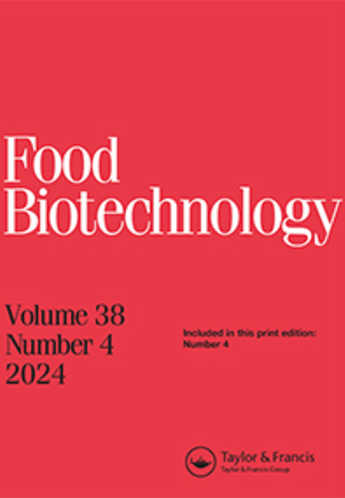石榴的生物活性研究离子凝胶法去除面粉中益生菌的活性
IF 1.6
4区 农林科学
Q4 BIOTECHNOLOGY & APPLIED MICROBIOLOGY
引用次数: 0
摘要
摘要食品工业中的重要成分,如作为益生元的膳食纤维,或具有抗氧化和抗菌活性的多酚,都可以从农工副产品中获得。本研究以石榴皮粉为包封剂,采用亲离子凝胶法制备合成胶囊。其中含有大量的不溶性纤维(27.2±1.4%),多酚具有良好的抗氧化能力(TEAC= 1121)和抗菌活性(与四环素相当,高于红霉素)。石榴皮粉的平均生长率和平均代数较高,说明乳酸菌代谢不溶性纤维的能力与益生元活性有关。石榴皮粉作为包封剂,提高了包封菌的活力,在贮藏过程中保持了平均生长速率不变。由于共包埋保持了较高的细胞活力(>80%),石榴皮粉可以作为益生元共包埋剂开发食品工业的共生成分。特别感谢Manuel Viuda-Martos博士,西班牙Miguel大学(Hernández de Elche)的CIAGRO,他在酚类化合物谱测定方面提供了宝贵的帮助。披露声明作者未报告潜在的利益冲突。本文章由计算机程序翻译,如有差异,请以英文原文为准。
Bioactivity of Pomegranate ( Punica granatum L .) Peels Flour to Improve Probiotics Viability in Micro Co-Encapsulation by Ionic Gelation
ABSTRACTImportant ingredients in the food industry, like dietary fiber as prebiotic, or polyphenols with antioxidant and antimicrobial activity, can be obtained from agro-industrial coproducts. In this research, pomegranate peel flour was employed as co-encapsulant by ionotropic gelation to obtain a synbiotic capsule. There was a considerable amount of insoluble fiber (27.2±1.4 %) and the polyphenols demonstrated an acceptable antioxidant capacity (TEAC= 1121) and antimicrobial activity as well (equal to tetracycline, higher than erythromycin). Pomegranate peel flour resulted in higher mean growth rate values and mean generation times, indicating the LAB capacity to metabolize the insoluble fiber, related to prebiotic activity. As co-encapsulant ingredient, pomegranate peel flour, enhanced the viability of the encapsulated probiotic strains, maintaining the mean growth rate constant during storage. Since co-encapsulation maintained a high cells viability (>80%), the pomegranate peel flour can be employed as a prebiotic co-encapsulant to develop symbiotic ingredients for the food industry.KEYWORDS: Antimicrobial activityantioxidant capacityprebiotic activity scoreco-encapsulationsynbiotic AcknowledgmentsSpecial thanks to Dr Manuel Viuda-Martos, CIAGRO at the Universidad Miguel Hernández de Elche, Spain, for his invaluable assistance in the phenolic compounds profile determination.Disclosure statementNo potential conflict of interest was reported by the author(s).
求助全文
通过发布文献求助,成功后即可免费获取论文全文。
去求助
来源期刊

Food Biotechnology
工程技术-生物工程与应用微生物
CiteScore
3.80
自引率
0.00%
发文量
15
审稿时长
>12 weeks
期刊介绍:
Food Biotechnology is an international, peer-reviewed journal that is focused on current and emerging developments and applications of modern genetics, enzymatic, metabolic and systems-based biochemical processes in food and food-related biological systems. The goal is to help produce and improve foods, food ingredients, and functional foods at the processing stage and beyond agricultural production.
Other areas of strong interest are microbial and fermentation-based metabolic processing to improve foods, food microbiomes for health, metabolic basis for food ingredients with health benefits, molecular and metabolic approaches to functional foods, and biochemical processes for food waste remediation. In addition, articles addressing the topics of modern molecular, metabolic and biochemical approaches to improving food safety and quality are also published.
Researchers in agriculture, food science and nutrition, including food and biotechnology consultants around the world will benefit from the research published in Food Biotechnology. The published research and reviews can be utilized to further educational and research programs and may also be applied to food quality and value added processing challenges, which are continuously evolving and expanding based upon the peer reviewed research conducted and published in the journal.
 求助内容:
求助内容: 应助结果提醒方式:
应助结果提醒方式:


